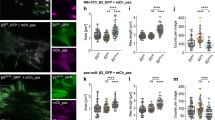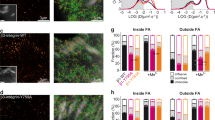Abstract
Focal adhesion kinase (FAK) is a tyrosine kinase found in focal adhesions, intracellular signaling complexes that are formed following engagement of the extracellular matrix by integrins. The C-terminal 'focal adhesion targeting' (FAT) region is necessary and sufficient for localizing FAK to focal adhesions. We have determined the crystal structure of FAT and show that it forms a four-helix bundle that resembles those found in two other proteins involved in cell adhesion, α-catenin and vinculin. The binding of FAT to the focal adhesion protein, paxillin, requires the integrity of the helical bundle, whereas binding to another focal adhesion protein, talin, does not. We show by mutagenesis that paxillin binding involves two hydrophobic patches on opposite faces of the bundle and propose a model in which two LD motifs of paxillin adopt amphipathic helices that augment the hydrophobic core of FAT, creating a six-helix bundle.
This is a preview of subscription content, access via your institution
Access options
Subscribe to this journal
Receive 12 print issues and online access
$189.00 per year
only $15.75 per issue
Buy this article
- Purchase on Springer Link
- Instant access to full article PDF
Prices may be subject to local taxes which are calculated during checkout




Similar content being viewed by others
References
Hynes, R.O. Cell 69, 11–25 (1992).
Parsons, J.T., Martin, K.H., Slack, J.K., Taylor, J.M. & Weed, S. Oncogene 19, 5606–5613 (2000).
Schaller, M.D. Biochim. Biophys. Acta 1540, 1–21 (2001).
Hanks, S.K. & Polte, T.R. Bioessays 19, 137–145 (1997).
Calderwood, D.A. et al. J. Biol. Chem. 274, 28071–28074 (1999).
Patil, S. et al. J. Biol. Chem. 274, 28575–28583 (1999).
Schaller, M.D., Otey, C.A., Hildebrand, J.D. & Parsons, J.T. J. Cell Biol. 130, 1181–1187 (1995).
Hildebrand, J.D., Schaller, M.D. & Parsons, J.T. J. Cell Biol. 123, 993–1005 (1993).
Tachibana, K., Sato, T., D'Avirro, N. & Morimoto, C. J. Exp. Med. 182, 1089–1100 (1995).
Chen, H.-C. et al. J. Biol. Chem. 270, 16995–16999 (1995).
Schlaepfer, D.D., Hanks, S.K., Hunter, T. & van der Geer, P. Nature 372, 786–791 (1994).
Hynes, R.O. & Zhao, Q. J. Cell Biol. 150, F89–F95 (2000).
Sparks, A.B. et al. Proc. Natl. Acad. Sci. USA 93, 1540–1544 (1996).
Holm, L. & Sander, C. Nucleic Acids Res. 25, 231–234 (1997).
Bakolitsa, C., de Pereda, J.M., Bagshaw, C.R., Critchley, D.R. & Liddington, R.C. Cell 99, 603–613 (1999).
Cooley, M.A., Broome, J.M., Ohngemach, C., Romer, L.H. & Schaller, M.D. Mol. Biol. Cell 11, 3247–3263 (2000).
Brown, M.C., Perrota, J.A. & Turner, C.E. J. Cell Biol. 135, 1109–1123 (1996).
Brown, M.C., Curtis, M.S. & Turner, C.E. Nature Struct. Biol. 5, 677–678 (1998).
Thomas, J.W. et al. J. Biol. Chem. 274, 36684–36692 (1999).
Nikolopoulos, S.N. & Turner, C.E. J. Biol. Chem. 276, 23499–23505 (2001).
West, K.A. et al. J. Cell Biol. 154, 161–176 (2001).
Pokutta, S. & Weis, W.I. Mol. Cell 5, 533–543 (2000).
Yang, J., Dokurno, P., Tonks, N.K. & Barford, D. EMBO J. 20, 3645–3656 (2001).
Liddington, R.C. & Bankston, L.A. Exp. Cell Res. 261, 37–43 (2000).
Bass, M.D., Smith, B.J., Prigent, S.A. & Critchley, D.R. Biochem. J. 341, 257–263 (1999).
Otwinowski, Z. & Minor, W. Methods Enzymol. 276, 307–326 (1997).
Terwilliger, T.C. & Berendzen, J. Acta Crystallogr. D 55, 849–861 (1999).
Collaborative Computational Project, Number 4 Acta Crystallogr. D 50, 760–763 (1994).
Roussel, A. & Cambillau, C. in Silicon graphics geometry partners directory (Program Manual) 86 (Silicon Graphics, Mountain View, California; 1991).
Brünger, A.T. et al. Acta Crystallogr. D 54, 905–921 (1998).
Turner, C.E. & Brown, M.C. Methods Enzymol. 298, 77–89 (1998).
Nicholls, A., Sharp, K.A. & Honig, B. Protein Struc. Func. Genet. 11, 281–296 (1991).
Acknowledgements
We are grateful to the Brookhaven National Laboratory for synchrotron access. Supported by grants from the NIH to R.C.L. and K.V.
Author information
Authors and Affiliations
Corresponding author
Ethics declarations
Competing interests
The authors declare no competing financial interests.
Rights and permissions
About this article
Cite this article
Hayashi, I., Vuori, K. & Liddington, R. The focal adhesion targeting (FAT) region of focal adhesion kinase is a four-helix bundle that binds paxillin. Nat Struct Mol Biol 9, 101–106 (2002). https://doi.org/10.1038/nsb755
Received:
Accepted:
Published:
Issue Date:
DOI: https://doi.org/10.1038/nsb755
This article is cited by
-
Repositioning of experimentally validated anti-breast cancer peptides to target FAK-PAX complex to halt the breast cancer progression: a biomolecular simulation approach
Molecular Diversity (2023)
-
ZINC40099027 promotes monolayer circular defect closure by a novel pathway involving cytosolic activation of focal adhesion kinase and downstream paxillin and ERK1/2
Cell and Tissue Research (2022)
-
FAK displacement from focal adhesions: a promising strategy to target processes implicated in cancer progression and metastasis
Cell Communication and Signaling (2021)
-
Striated muscle proteins are regulated both by mechanical deformation and by chemical post-translational modification
Biophysical Reviews (2021)
-
Sequence analysis of the cDNA encoding for SpCTx: a lethal factor from scorpionfish venom (Scorpaena plumieri)
Journal of Venomous Animals and Toxins including Tropical Diseases (2018)



